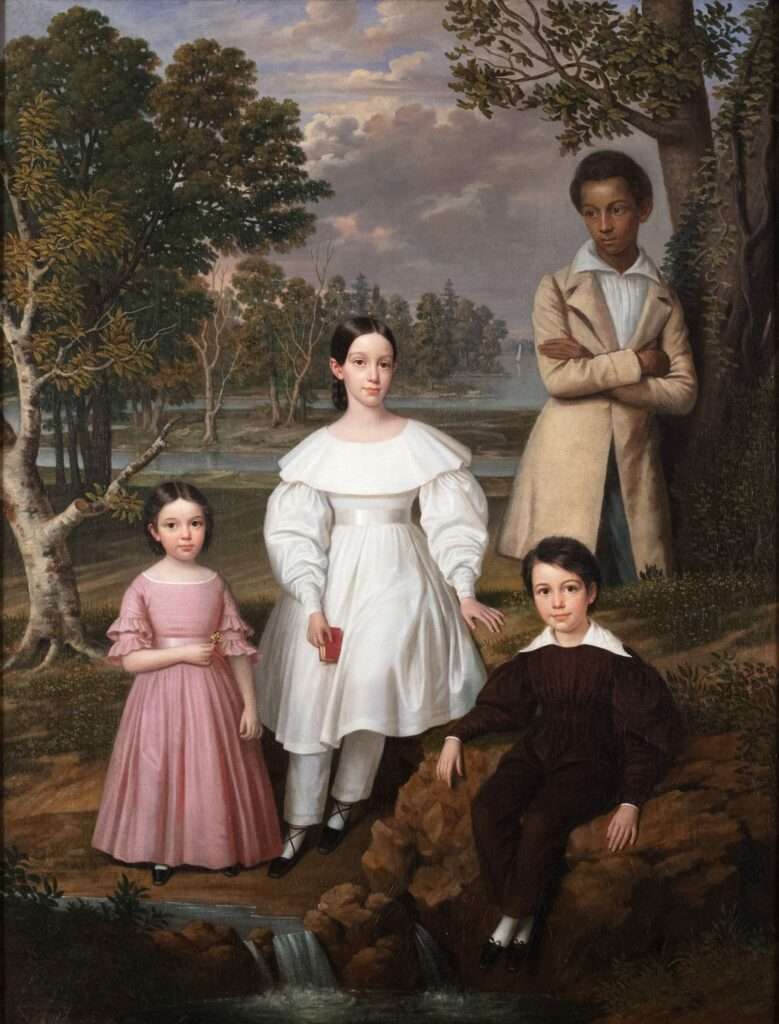Bélizaire and the Frey children is a work dated 1837 and attributed to the French-American neoclassical painter and portraitist Jacques Guillaume Lucien Amans (1801-1888), who worked in New Orleans between the 1830s and 1850s and was popular with the local elite. The painting depicts, from left to right, Léontine, Elisabeth and Frédéric, the children of Frédérick Frey, a German-born banker and merchant who lived in a mansion in the French Quarter of New Orleans, and Colette Coralie Favre D’Aunoy, a member of an illustrious family in the city dating back to the colonial era (1507-1773).
But the distinctive feature of this American work from the first half of the 19th century is above all the presence of a mixed-race adolescent, lost in thought and subtly tucked away against a tree, who accompanies the three white children, fresh and smiling against the backdrop of the Bayou. The work obviously raises many questions, as it is one of the very rare examples of a portrait of a slave-owning family of European origin that has chosen to include the portrait of a young man of African descent, suggesting that he was a valued member of the household despite his status as a slave. This mysterious figure was not always visible, however, because between the end of the 19th and the beginning of the 20th century, for reasons that are still unclear, he was concealed in the décor under layers of paint, even though a shadow could always be cast to reveal his presence. “No white person, whatever their social status, in New Orleans at that time would have wanted a black person to be represented and exhibited with their family”, explains Katy Shannon, a specialist in the history of Louisiana. The rise of racism in the United States after the abolition of slavery in 1865 probably also contributed to the desire to hide this embarrassing figure.
Born in January 1822 in the French Quarter to an unknown father and a slave mother, and identified under the first name of Bélizaire, the mystery figure was in fact bought by the Frey family when he was just six years old. Aged around 15 at the time the painting was made, he was probably the guardian of his owner’s children. While the two daughters Elizabeth and Léontine Frey died of yellow fever in 1837 (the year the painting was done) at the age of five and nine respectively, the son Frederick did not survive much longer. As for Bélizaire, the only character in the painting to reach adulthood, he was then sold for $1,200 with Sally, his mother cook, in 1856 to the famous Evergreen sugar cane plantation, following the death of Frédéric Frey and the bankruptcy of his businesses. As there is no trace of Bélizaire in the archives of the time after 1861, other legitimate questions arise: did he survive the Civil War (1861-65)? Were there any descendants? Several generations later, in 1972, Audrey Grasser, the great-great-granddaughter of Coralie Favre D’Aunoy, finally chose to donate the painting to the New Orleans Museum of Art (NOMA) which, unaware of the artist’s name, was content to store it for 32 years in its reserves, instead of exhibiting it or seeking to unveil the blurred contours of the obscured figure. In 2005, the work was finally sold at auction at Christie’s in New York to a Virginia collector for $7,000.
In 2021, collector and historian Jeremy Simien, a ninth-generation Creole of African and European descent and himself passionate about exploring his family heritage, bought the painting, haunted by the fact that Bélizaire had been concealed. After completing the restoration of the work, he asked historian Katy Shannon to investigate the figures depicted in the census records of the time. “This is a major discovery. People will finally know the name and face of the fourth character. Belizaire is the replacement for so many people whose pictures were not painted and whose stories were not told,” explains Katy M. Shannon. The collector finally decided to part with this precious piece that had fascinated him, convinced that it belonged in a museum.
After being on display for more than six months at the Ogden Museum of Southern Art, the painting Bélizaire and the Frey Children finally arrived in New York this spring, acquired by New York’s renowned Metropolitan Museum of Art, hoping to bring back to life the young mixed-race boy who has been painted out of history, both literally and figuratively, for more than 100 years. Neither the Met nor Jeremy Simien would disclose the amount paid by the museum. “Without the invaluable efforts of Jeremy Simien and Katy Shannon to discover the identity of this young man, the painting would probably still be in a private collection, out of sight and unknown. The acquisition of this rare painting is an exceptional asset for the American wing of our institution, being the first naturalistic portrait of an identified black subject set in a Louisiana landscape. It allows us to break with the romanticised history of American art and address many of the absences and asymmetries in the collection as we approach the 100th anniversary of the American Wing in 2024,” says Sylvia Yount, curator at the New York museum. Since the emergence of the Black Lives Matter movement, several international museums have responded to calls to take into account the representation of black figures and expose the roots of systemic inequalities. At New York’s Metropolitan Museum of Art, since the reopening of the European galleries in 2020, the museum has included wall texts to highlight the presence of Africans in Europe and draw attention to hitherto ignored issues of racism.
Text by Christine Cibert.
Cartel of the work:
Bélizaire et les enfants Frey, oil on canvas, 120 x 92 cm, created in 1837 in New Orleans, attributed to the artist Jacques Amans (1801-1888), modified at the end of the 19th century, restored in 2005 and again in 2021, conserved since spring 2023 at the Metropolitan Museum of Art in New York.



